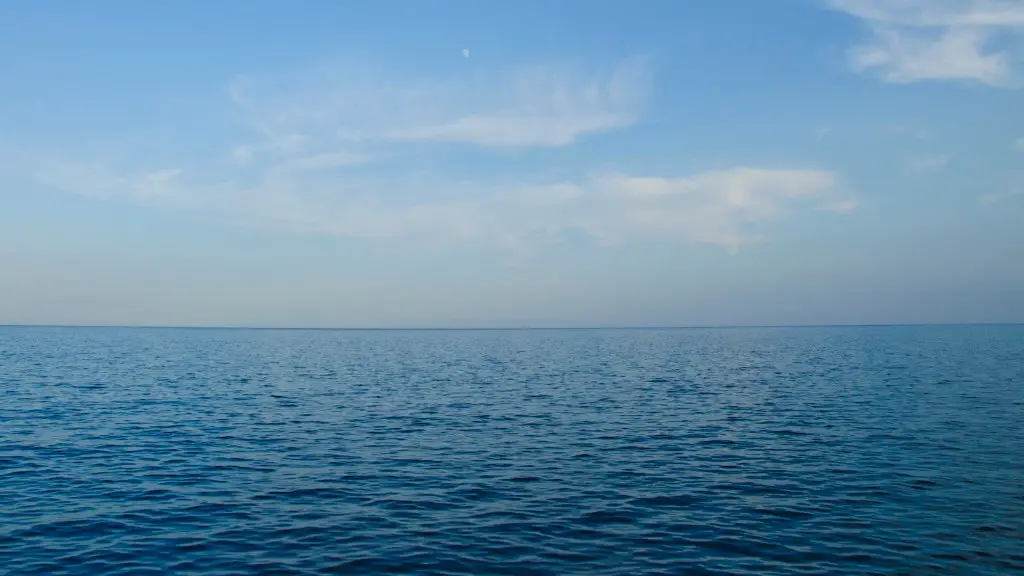The South China Sea has a long and complicated history, one that involves territorial disputes, conflicting claims, and rivalries. With China’s ambitious ‘One Belt, One Road’ program adding a new layer of complexity to the mix, the question of how the country can claim a portion of the territory has become even more pressing. China’s claim to the area is backed by historical evidence and its presence in the region, but there is also a large number of countries and international organizations that have their own interests in the South China Sea.
China’s main basis for claiming the South China Sea is its long history in the area. China has a longstanding and ancient claim to the majority of the South China Sea, with evidence of Chinese presence in the area as far back as the 2nd century BC. In addition to its historical claim, China has also argued that it has had continuous and unbroken presence in the region for centuries, as evidenced by its historical control of surrounding islands and its own fishing fleets in the area.
In addition to the historical argument, China has also used the principle of ‘historic rights’ to reinforce its claim to parts of the South China Sea. This principle is based on the idea that China was the first nation to exercise ‘sovereignty’ over the area, and therefore has a right to continue to do so. China has also argued that, since the other countries in the dispute have not made strong enough claims to the area, it should have the right to control the majority of it.
Despite these arguments, however, there is a long list of countries and international organizations who have disputed China’s claim to the South China Sea. This includes neighboring countries such as Vietnam, Malaysia and the Philippines, as well as the United Nations, who have all forwarded strong arguments against China’s claims. In addition, the United States has been a vocal critic of China’s attempts to assert its control over the area, citing concerns about freedom of navigation and the need to keep international waters open for all.
Given the complexities of the dispute, it is difficult to say how China can definitively ‘claim’ the South China Sea. The best solution may be to find a negotiated solution that takes into account both China’s historical rights and the claims of other countries, while still preserving freedom of navigation in the area. China has been an active participant in negotiations aimed at resolving the dispute, but so far these have been unsuccessful. Until a consensus is reached, the question of how China can claim the South China Sea will likely remain unanswered.
Rival interests in the South China Sea
The South China Sea has long been a source of contention among the countries in the region, with several countries laying claim to parts of the disputed area. Vietnam, Malaysia, Taiwan and the Philippines are among the countries that have staked claims to certain parts of the South China Sea, with the waters being a potential source of both economic and strategic resources. The presence of rival interests only adds to the complexity of the situation, with each country jostling to assert their right to the region.
The economic value of the South China Sea lies in its rich supply of fish and minerals, as well as its potential to be a major shipping hub connecting East Asian countries to the Middle East and Europe. This has made the area especially attractive to China, which aims to use the region as a strategic back door to the world. China’s increasingly assertive stance in the region has been met with resistance from countries like the Philippines, who take issue with what they view as Chinese encroachment into their sovereign waters.
The waters of the South China Sea are also a potential source of oil and natural gas. This has drawn the attention of several countries in Southeast Asia, who are also eager to tap into the resources of the region. China is well aware of the potential economic value of the South China Sea and has attempted to use its ‘nine-dash line’ to assert its exclusive rights over the area. However, other countries have resisted this move, arguing that it would violate their own territorial boundaries.
Finally, the South China Sea also has a strategic importance in terms of military operations. With its vast size and abundance of islands, it is an ideal location for conducting operations ranging from ship-to-ship combat to amphibious assaults. This has made the area a hotbed of military activity, with the United States, China and other countries all vying for control. This has further complicated the question of how China can claim the South China Sea.
International Maritime Law in the South China Sea
The South China Sea dispute is complicated by the presence of a number of international maritime laws, with different countries having different interpretations of which laws apply to the region. China has historically argued that its nine-dash line is based on the United Nations Convention on the Law of the Sea (UNCLOS), an international agreement that grants coastal states control over waters within their 200-nautical-mile Exclusive Economic Zone (EEZ). This, however, has been contested by some countries, who argue that UNCLOS only applies to the waters within 12 nautical miles of a coast, rather than the entire EEZ.
The Philippines has also put forward its own argument, the ‘Regime of Islands’ theory, which claims that the islands in the South China Sea have their own EEZs and that each country should be able to claim the waters within their respective EEZ. This, in turn, has been challenged by China, which has argued that the islands are only entitled to the waters which fall within their 120-mile territorial waters.
Furthermore, the United States and other countries have also put forward their own interpretations of international maritime law, with the US arguing that all countries have the right to freedom of navigation and overflight in the South China Sea. This has been met with strong opposition from China, which has insisted that other countries respect its own ‘right of innocent passage’ through the area. This has added another layer of complexity to the dispute, further complicating the question of how China can claim the South China Sea.
Regional and International Organizations getting involved
In order to address the increasing tensions in the South China Sea, a number of regional and international organizations have become involved in the dispute. The most prominent of these is the Association of Southeast Asian Nations (ASEAN), which has sought to mediate the dispute and encourage dialogue between the countries in the region. ASEAN has also created several regional initiatives that seek to maintain peace in the area, such as the Committee on the South China Sea (CSCS) and the informal process for settling disputes.
In addition, the United Nations has also become increasingly involved in the dispute, with its Permanent Court of Arbitration ruling in favor of the Philippines in 2016. This ruling has been interpreted as a strong rebuke of China’s claim to the majority of the South China Sea, although China has refused to accept the tribunal’s findings. The United States has also played a role in the dispute, with the US Navy conducting ‘freedom of navigation’ operations in the disputed Waters.
Finally, the United States and other countries have also sought to use international economic sanctions to pressure China into dropping its claim to the South China Sea. However, these measures have been largely unsuccessful, with China refusing to budge on its stance towards the region. This has left China with few options for how it can claim the South China Sea, with negotiations and international mediation seeming to be the most likely path forward.
Implications for future conflict in the region
Given the complex nature of the South China Sea dispute, it is difficult to predict what the future of the region will be. China’s increasingly assertive stance in the area has stirred up conflict with its neighbors, raising concerns about the potential for a military conflict in the future. Furthermore, the involvement of international organizations and the potential for economic sanctions could further complicate the dispute.
The best solution to the dispute will likely come through dialogue and negotiation. However, given the entrenched positions of the different countries and the lack of progress in negotiations, it is unclear how this will be achieved. Until a consensus is reached, the South China Sea dispute is likely to remain a source of tension in the region, with its implications for future conflict still hanging in the balance.
China’s Strategic Ambitions in the South China Sea
China’s strategic goals in the South China Sea have become increasingly apparent in recent years, with the country attempting to assert its influence in the region. China’s actions in the region have been widely viewed as an attempt to gain a strategic advantage over its rivals, with the country’s efforts to construct military bases and other infrastructure seen as clear attempts to dominate the area.
China’s increased assertiveness has also been seen in its diplomatic maneuvers, with the country attempting to use a combination of threats, intimidation and economic coercion to weaken the resolve of its rivals. China’s biggest concern has been the United States and its allies, who have become increasingly active in the region in recent years. The US Navy has conducted several ‘freedom of navigation’ operations in the area, which have been met with strong resistance from China.
In addition to its military presence, China has also put an emphasis on economic development in the region, with the country attempting to use economic incentives to win the allegiance of countries in the region. This has been seen in China’s ‘One Belt, One Road’ program, which has sought to win the support of countries in Southeast Asia by providing them with economic assistance. This has raised concerns among some countries, who view China’s actions as a way of gaining geopolitical influence in the region.
Finally, China has also sought to bolster its diplomatic influence in the region, by attempting to court the support of countries like the Philippines, who have been strong opponents of China’s actions. However, this seems to have had limited success, with many countries still standing firm against China’s attempts to assert its control over the South China Sea.
Conclusion
The South China Sea dispute is a complex and contentious issue that has embroiled a number of countries and international organizations. China has a longstanding presence in the region and has argued that it has a right to a portion of the territory, based on historical claims, ‘historic rights’, and its own interpretation of international maritime law. However, its claim has been contested by the United Nations and other countries, who have put forward their own arguments and interpretations.
In addition to the legal arguments, the presence of rival interests and strategic ambitions in the region must also be taken into account. As a result, the question of how China can ‘claim’ the South China Sea remains unanswered for now, and the best solution may be to find a negotiated solution that takes into account all parties’ claims and interests. Until then, the dispute is likely to remain a source of tension in the region, with its implications for future conflict still hanging in the balance.





